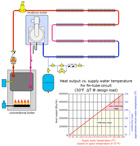One After The Other
In some systems, outdoor reset control can vary the supply
water temperature from a relatively high design temperature down to just above room temperature.

One technique that compensates for this is to supply the load with a condensing boiler when the supply water temperature is low, and then invoke a conventional boiler for added capacity as conditions approach design load. This is a less expensive way to add capacity, while recognizing that “non-condensing” conditions don’t justify the added cost of a condensing boiler.
The schematic below shows a system installed with that intent. The mod/con boiler would operate during “shoulder seasons” when supply water temperatures are such that flue gases will condense. The conventional boiler would come online as outdoor temperatures drop and the load increases.
Exercise: Can you find a few things that need changing?

Piping the boilers in parallel with individual circulators and check valves solves this issue.
Another issue is the head loss associated with all components in series. While it’s likely that a circulator with sufficient head could be selected, the operating cost will be higher than other options.
The single circulator is also poorly positioned relative to the expansion tank. In this configuration the circulator is “sucking” water through the relatively high resistance of the mod/con boiler.
In the Fix drawing, the expansion tank is near the hydraulic separator. In this configuration all circulators are “pumping away” from the effective point of no pressure change (e.g., the hydraulic separator).
The series circuit with a design load ∆T of 30 ºF is not necessarily a problem provided piping is sized for a modest head loss. The higher ∆T reduced flow rate and hence reduces head loss. The higher ∆T also encourages lower return water temperatures, which enhances condensing mode operation.

The Glitch
The Glitch
Overview: Outdoor reset control of hydronic heat sources reduces operating cost. In some systems, outdoor reset control can vary the supply water temperature all the way from a relatively high design temperature of say 170 or 180 ºF, down to just above room temperature. Although a condensing boiler can be used to supply such a wide temperature range, it will not condense when operating at the upper part of such a temperature range.One technique that compensates for this is to supply the load with a condensing boiler when the supply water temperature is low, and then invoke a conventional boiler for added capacity as conditions approach design load. This is a less expensive way to add capacity, while recognizing that “non-condensing” conditions don’t justify the added cost of a condensing boiler.
The schematic below shows a system installed with that intent. The mod/con boiler would operate during “shoulder seasons” when supply water temperatures are such that flue gases will condense. The conventional boiler would come online as outdoor temperatures drop and the load increases.
Exercise: Can you find a few things that need changing?

The Fix
The Fix
The chief issue that needs correction is the series piping of the boilers. Under low load conditions, the mod/con boiler would be operating, and warm water will flow through the distribution system as well as the unfired conventional boiler. The latter is just a source of heat loss to the mechanical room.Piping the boilers in parallel with individual circulators and check valves solves this issue.
Another issue is the head loss associated with all components in series. While it’s likely that a circulator with sufficient head could be selected, the operating cost will be higher than other options.
The single circulator is also poorly positioned relative to the expansion tank. In this configuration the circulator is “sucking” water through the relatively high resistance of the mod/con boiler.
In the Fix drawing, the expansion tank is near the hydraulic separator. In this configuration all circulators are “pumping away” from the effective point of no pressure change (e.g., the hydraulic separator).
The series circuit with a design load ∆T of 30 ºF is not necessarily a problem provided piping is sized for a modest head loss. The higher ∆T reduced flow rate and hence reduces head loss. The higher ∆T also encourages lower return water temperatures, which enhances condensing mode operation.
Links
Looking for a reprint of this article?
From high-res PDFs to custom plaques, order your copy today!






